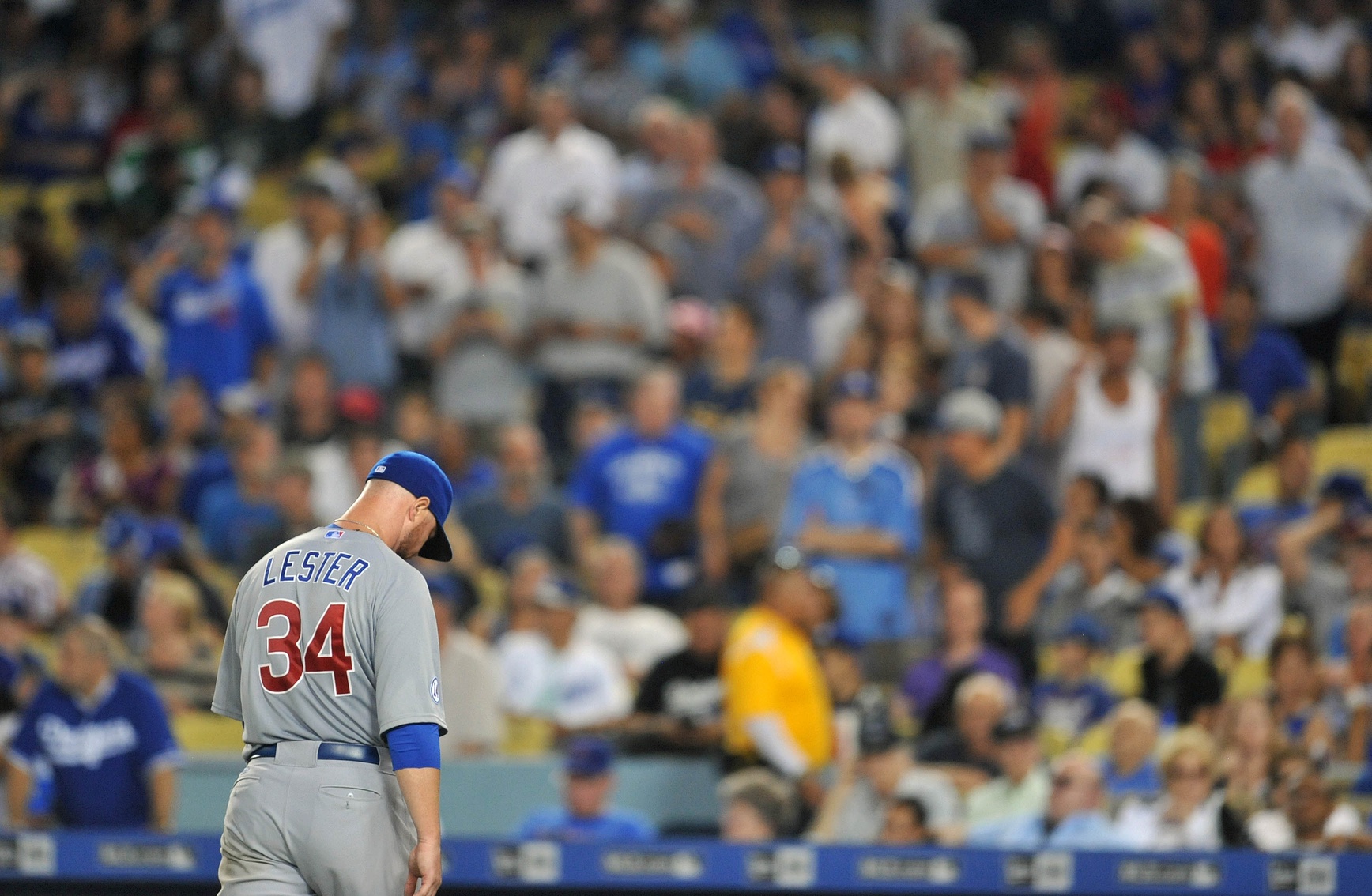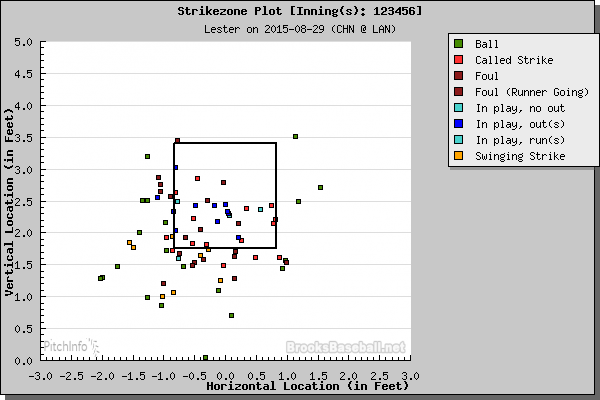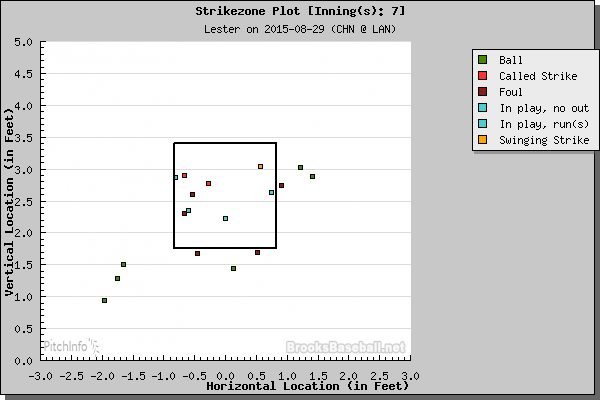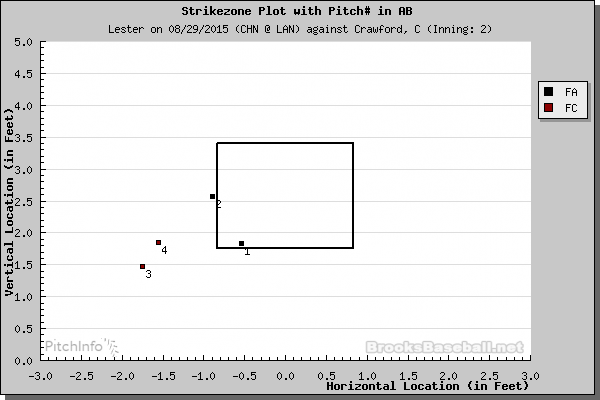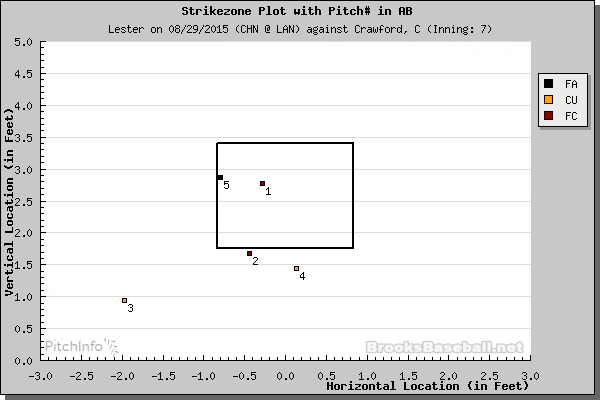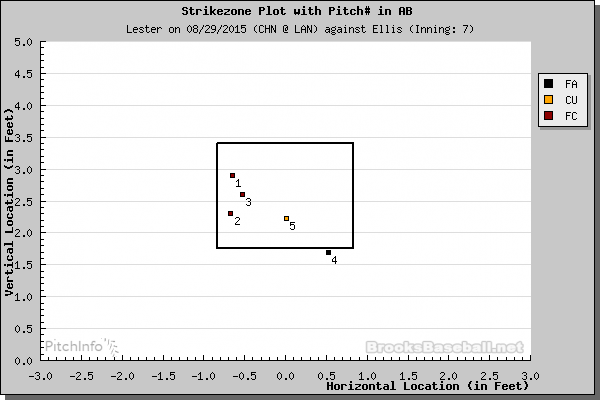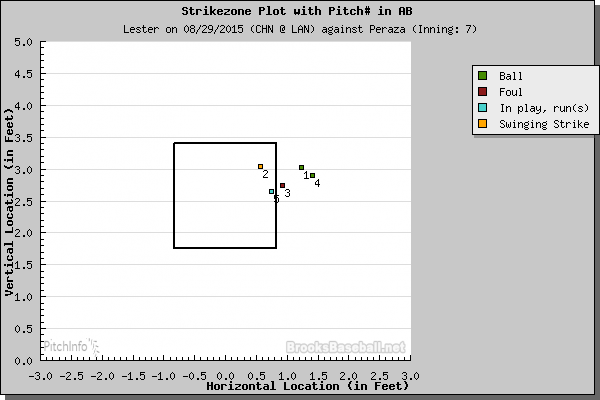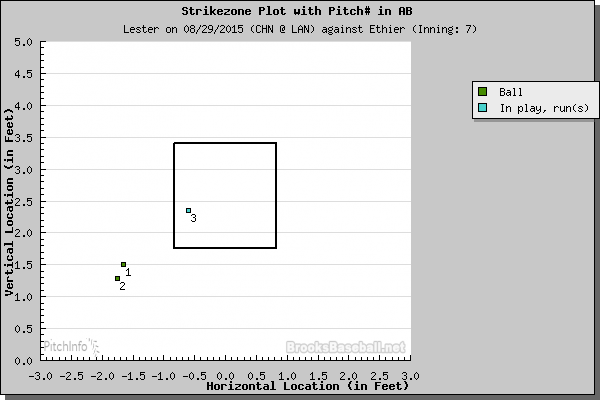Date: August 29, 2015
Opponent: Los Angeles Dodgers
Location: Dodgers Stadium
Introduction
Unlike Henry Rowengartner’s late season trip to Chavez Ravine, Jon Lester’s time in Dodgers Stadium did not result in a victory or the chanting of “We want a pitcher, not a belly itcher” to a large, mustachioed Dodger on the mound. It was not nearly as madcap or family friendly as the movie. In fact, much like his 2015 numbers against the Detroit Tigers, Lester’s two starts against the Dodgers have produced some unpleasant results:
| Innings Pitched | ERA | WHIP | Batter’s Faced | Hits | Walks | Extra-Base Hits | AVG | OBP | SLP |
| 10.0 | 8.10 | 1.600 | 46 | 12 | 4 | 4 | .286 | .348 | .452 |
By Game Score (43), Saturday was Lester’s second worst start since the All Star break. The eight hits were the most he has given up since June 9th at Detroit. Despite recording seven strikeouts, Lester surrendered five hits on two-strike counts, including three of the four hits in the seventh inning. In his first four August starts, he surrendered just three hits on two-strike counts.
It was not all bad, though, and in fact, it was mostly good. Lester rediscovered his four-seam fastball as a strikeout pitch, continued to use his curve effectively late in counts, and kept the Dodgers off the basepaths. In innings one through six, Lester was able to be productive in the strike zone, producing eight outs and eight called strikes on pitches over the plate:
In the seventh inning, though, the Dodgers did the entirety of their damage off pitches in the strike zone, with all four hits coming off pitches up and over the plate:
Through six innings, he got ahead of 15 of 23 batters (65.2 percent, about five percent above his season average). and allowed just four baserunners. He used his three go-to pitches—four-seam fastball, cut fastball, curveball—to pick up his seven strikeouts.
The Dodgers offense getting to Lester eventually was not a shock, as entering the game, the team led the National League in walk rate (9.2 percent) and on-base percentage (.328), and ranked second in OPS (.750). The team has been even better this season against left-handed pitchers (.264/.341/.420), leading the NL in walk rate, OBP, and OPS against lefties, while ranking second in slugging percentage (.420) and third in ISO (.156). As a team against left-handers, the Dodgers get on base and hit for power.
However, the Dodgers offense had struggled in their previous 10 games, hitting just .202/.285/.321 with 23.7 percent strikeout rate.
Saturday night their offense got back on track, even if it was just for one inning. Otherwise, Lester was very good for six innings, before it unraveled in a four-batter stretch that featured some curious pitch selection (see Key At-Bats/Sequence section). And at the end of the night, all Lester has to show for his six outstanding innings is that damn Randy Newman song. Keep reading to learn how it fell apart in the shadow of palm trees.
Traditional Line
6.0 IP, 8 H, 7 K, 0 BB, 5 ER
Pitch Breakdown
96 pitches (70 strikes)
| Total | Velocity (Max) | AVG | SLG | BABIP | |
| Four-Seam | 35 | 93.8 (95.7) | .333 | .500 | .444 |
| Cutter | 29 | 88.7 (91.6) | .500 | .500 | .600 |
| Sinker | 9 | 93.2 (95.0) | .000 | .000 | .000 |
| Change-Up | 9 | 86.9 (87.7) | .000 | .000 | .000 |
| Curveball | 13 | 77.1 (78.3) | .200 | .200 | .500 |
Lester induced just one whiff with his four-seam fastball, and allowed four hits, including both doubles, off the pitch. The good news is Lester picked up three strikeouts with his four-seamer, matching his combined total from his four previous August starts.
In two games against Lester’s four-seamer and cutter, the Dodgers went 11-for-32 with three doubles and a triple. In the two starts, he has gone to his four-seamer and cutter a combined 64.6 percent of all pitches (actually below his 68.18 percent usage rate on the season). However, if the Cubs and Dodgers meet again down the line, say in, oh, I don’t know October, maybe, then Lester might need to re-think his approach.
After Lester’s truncated first outing against the Dodgers, we wrote:
The 91.7 mph average velocity with the four-seam fastball represents Lester’s lowest velocity in a start in 2015. With each passing month, the four-seamer has become a bigger issue (see Trends section, if you have the stomach). On the day, Dodgers batters had no trouble with any of Lester’s fastballs, finishing 4-for-12 with four walks, a double, and a triple.
While his average velocity topped 93 mph this start, the four-seamer struggles, especially against the Dodgers, remains relevant.
Lester, though, did have his cutter working early. In Carl Crawford’s second-inning at-bat, Lester got ahead 0-and-2 with a four-seamer and cutter away, and then came back with an 90 mph cutter, on which Crawford just managed to check his swing. Lester and Montero came right back with an 89 mph cutter in the same spot, and this time Crawford chased and whiffed for strike three:
Lester went to his curve just 13.7 percent of pitches (13 of 95), striking out three and allowing just one hit, although it came during the Dodgers seventh inning rally (see Key At-Bat/Sequence section). In August, one third of Lester’s strikeouts came off the curve (10 of 30). Against the Dodgers, an amazing 11 of 13 curves came with two strikes. How much has Lester come to trust his curve as a strikeout pitch? When he faced the Dodgers on June 25th, just three of 12 curves came with two strikes.
While Lester’s cutter and curve emerged as consistent strikeout pitches, August was a rough month overall for most of his pitches:
| Pitch | Frequency | AVG | SLP | BABIP |
| Four-Seam | 42.01% | .333 | .513 | .375 |
| Cutter | 26.07% | .282 | .333 | .407 |
| Sinker | 9.63% | .125 | .313 | .071 |
| Change-Up | 4.60% | .500 | .750 | .667 |
| Curveball | 17.07% | .294 | .471 | .667 |
Lester’s BABIP , especially with the three pitches he throws with the greatest frequency (four-seam, cut, curve), increased significantly from July. While that does not explain away recent struggles, the Dodgers had multiple well placed balls on Saturday, and the Giants opened the month doing the same (see Buster Posey’s two bloop doubles). Lester’s velocity increased from July, and he is using all his pitches early and late in counts. I’ve basically gone the long way to say something simple in theory, but harder in practice: Don’t panic… yet.
Trends
With Pitch Breakdown and Key At-Bat/Sequence sections overflowing with analysis that a better writer might edit down, this Trends section will be brief. For the season’s five months we I yelled at #BaseballTwitter and strangers on the street about Lester’s dominant curve:
| Frequency | 2-strike Frequency | % of Strikeouts | Extra-Base Hits | AVG | SLP | BABIP | |
| April – July | 15.58% | 22.4% | 26.7% | 4 | .143 | .229 | .265 |
As the season has progressed, Lester’s curve frequency has only increased, and as his four-seamer was largely ineffective in August, the curve became a reliable pitch late in at-bats:
| Frequency | 2-strike Frequency | % of Strikeouts | Extra-Base Hits | AVG | SLP | BABIP | |
| August | 17.07% | 25.8% | 30.0% | 1 | .294 | .471 | .667 |
The hits he did surrender were mostly singles, and he was the victim of some (hopefully) unsustainable BABIP. This season, Lester’s curve has worked in unison with his fastballs, both to set-up his four-seamer and cutter, and to put away hitters set-up by the fastballs.
Key At-Bat/Sequence
Inning: Seventh Inning
Score: 2-1, Cubs ahead
Situation: Beginning of inning
Batter(s): Carl Crawford, A.J. Ellis, Jose Beraza, Andre Ethier
Through six innings, Lester was outstanding. It fell apart in the span of 18 pitches.
Carl Crawford led off the inning. In the Pitch Breakdown section, we detailed Lester’s second-inning strikeout of Crawford, in which he went back to the cutter in the same location a pitch after Crawford could not check his swing. In the seventh inning, Lester got ahead 0-and-2 with a four-seamer and cutter, and he attempted to go low and away again for the punchout, this time with a pair of curves that Crawford laid off of. With the count now even, Lester came back with a 93.7 mph four-seamer up and away:
Crawford lined it the other way for a base hit. It seemed like an odd pitch selection, as entering the game, in his career, Crawford had slugged .430 against four-seam fastballs from left-handed pitchers, but just .191 against cutters.
With one on and nobody out, A.J. Ellis came to the plate. In Ellis’s first at-bat, he took three high fastballs (one cutter and two four-seamers) for called strikes. In his second at-bat, Lester struck him out again, this time with a low curve on which Ellis whiffed. Lester opened Ellis’ third at-bat with a high four-seam fastball for a called strike (a theme against Ellis on the night), followed by Ellis fouling off three straight cutters. On 0-and-2, Lester came back with a curve, like in Ellis’ previous at-bat, but this time the curve stayed up in the strike zone:
Ellis went inside-out to bloop the ball into right for a single, and Lester now had runners on first and third with no outs.
Jose Peraza had six career plate appearances prior to Saturday night. In his first at-bat, Peraza singled on a 1-2 sinker. In the fourth inning, Peraza popped up a first-pitch 93.7 mph four-seamer. In Peraza’s third at-bat, he took a four-seamer away for ball one. On the second and third pitch, Lester stayed with the four-seamer up and away, picking up a whiff and foul ball, respectively. After Peraza laid off another four-seamer away, Lester stayed up with the four-seam fastball, but came back closer to the plate:
Peraza shot a double into the right-center field gap, scoring Crawford and sending Ellis to third base. Peraza saw four four-seamers up and away, and instead of mixing it up, Lester and Miguel Montero came back in slightly, and he seemed ready.
With a run in, runners on second and third , and nobody out, Andre Ethier pinch hit. This season, Ethier had been hitting .189/.211/.216 with one extra-base hit against left-handed pitchers. Lester started Ethier with two cutters off the plate, both of which he laid off. Behind 2-and-0, Lester came back with another cutter, and this one missed up and over the plate:
Ethier singled up the middle through the drawn in infield to make it 4-2. Again, it seemed like curious pitch selection, as since the start of 2014, Ethier had slugged .541 against cutters, but just .362 and .343 against the four-seamer and curve, respectively.
After 18 pitches, four batters, and four hits (three with two-strikes) on some odd pitch selection and a crucial missed location, Lester’s night was over.
Keep-In-Mind
Despite last week’s tremendous start against Cleveland, August was a rough month for Lester statistically, just a month after he was one of the best pitcher’s in baseball:
| Month | Avg. GameScore | Avg. Start | ERA | WHIP | OPS | BABIP | K% | BB% |
| April | 44 | 5.42 IP | 6.23 | 1.569 | .810 | .424 | 25.0% | 5.2% |
| May | 62 | 6.83 IP | 1.76 | 1.171 | .667 | .263 | 21.5% | 7.0% |
| June | 46 | 5.33 IP | 5.74 | 1.500 | .851 | .355 | 21.9% | 8.8% |
| July | 70 | 7.22 IP | 1.66 | 0.762 | .476 | .260 | 30.7% | 3.1% |
| August | 50 | 6.07 IP | 5.04 | 1.385 | .780 | .373 | 23.3% | 6.2% |
He averaged almost twice as many baserunners per inning, as his walk rate doubled, his BABIP rose more than 100 points, and his opponent’s OPS jumped more than 400 points. Lester does not appear to be losing arm strength, as his velocity with all three fastballs increased from July. As you can see, his season has a bizarre, every-other-month pattern, meaning September looks promising (also known as the “It’s an even year, which is why the San Francisco Giants will win the World Series” theory), and his BABIP will right itself.
Since the All Star break, despite his recent starts against the Tigers and Dodgers, Lester has the sixth best fWAR (1.3) and eigtht best FIP (2.74) among NL pitchers.
Conclusion
As we detailed in the Introduction, the Dodgers have been the NL’s best team against left-handed pitchers. However, for six innings, Lester was able to get ahead of Dodgers batters, limit base runners, and use his curve, cutter, and four-seam fastball to put away hitters. And he was really just a few pitches away from making it through the seventh with no damage. As BP-Wrigleyville’s benevolent leader Sahadev Sharma noted during the seventh inning:
https://twitter.com/sahadevsharma/status/637833711522840576
Lester had two poor starts in an 11 day stretch. The latter was followed 24 hours later by Jake Arietta’s no hitter to cap his historic August, causing national “personalities” (and a faction of #CubsTwitter) to use the opportunity to disparage Lester by comparison. Lester has not been Arietta in 2015 (few not named Kershaw or Verlander have been in recent history), but he has been among 10 best starters in the NL since May 1st. The seventh inning was rough, and the pitch selection suspect, but Lester has bounced back continuously this season. Besides, the solution is obvious: Bring back the Big Lebowski quotes.*
*I can’t just bring back the Lebowski quotes. Readers, this is not ‘Nam. This is a Baseball Prospectus article, there are rules.
Season to Date
8-10, 3.59 ERA (4.07 DRA), 1.209 WHIP, 24.6% K, 5.9% BB
Next Start
Friday, September 4 vs. Arizona Diamondbacks at Wrigley Field
Lead photo courtesy of Gary A. Vasquez-USA TODAY Sports
